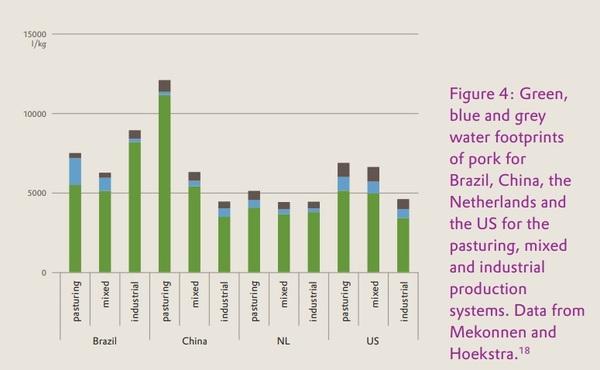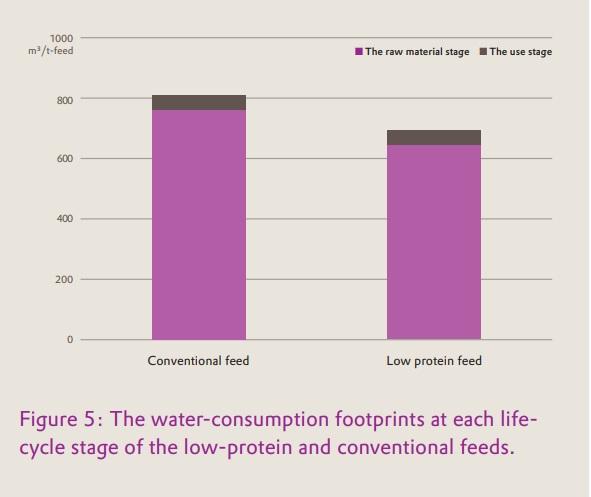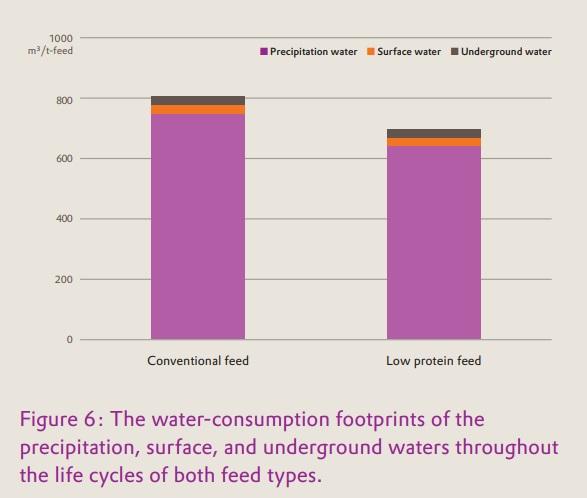Evonik’s animal feed solutions quench livestock thirst and reduce the environmental impact of meat and dairy production
WHITEPAPER
According to the UN, four billion people experience severe water scarcity for at least a month a year – and due to our unsustainable use of freshwater and other resources, water stress will increase further. One of the drivers is water-intensive meat and dairy production, which accounts for roughly a quarter of the global water footprint. Supplementing low-protein animal feed with amino acids helps produce meat with less freshwater use and contamination.
In 1972, the Apollo 17 crew took an iconic photo that soon became a symbol of the environmental movement. From a distance of 29,000 kilometers, Earth stands out from the blackness of space, isolated, frail and vulnerable – and covered by life-giving water. The Blue Marble strikingly shows there’s no shortage of water, but the bulk of it fills the oceans as sea water, is bound in ice caps and glaciers, hidden deep below ground or otherwise unavailable to us. If the world’s water supply was a hundred liters, the useable freshwater would amount to half a teaspoon or 0.003 liters.
Plenty of water – but not always and everywhere
Still, there’d be enough water for each of us if it was distributed equally. But while most people in the industrialized world just have to turn the kitchen tap for clean, safe freshwater, 844 million people don’t have access to basic water services, and 2.1 billion lack safely managed drinking water services according to the UN’s Sustainable Development Goal 6 Synthesis Report 2018 on Water and Sanitation.2 Moreover, around four billion people experience severe physical water scarcity for at least a month a year, due to shifts in seasonal availability through climate change increasingly also in regions where water resources are abundant for most of the time.3 Our use of freshwater is not sustainable. That’s a reason why the sixth of the UN’s 17 Sustainable Development Goals (SDG) – “Ensure availability and sustainable management of water and sanitation for all” – expressly includes reducing pollution, increasing water-efficiency across all sectors, and ensuring sustainable withdrawals.4
But over the past 100 years, global water use has increased by a factor of six – and with the world’s increasing population, economic development and shifting consumption patterns, the trend continues.5 The UN Environment Programme (UNEP) projects that more than half of the world’s population will live in areas where less than 1,000 cubic meters of water per person per year – defined by the Falkenmark Water Stress Indicator as water scarcity – will be available by 2050. Between 1,000 and 1,700 cubic meters, intermittent water shortages occur. For comparison, 3,000 cubic meters annually are available to people living in the EU today, and 9,000 cubic meters to people living in the United States.6 The resulting water scarcity poses economic threats to many countries, particularly in Western Asia and North Africa where it could cost up to 6 percent of GDP by 2050 as per the World Bank.7
Growing demand for animal protein
Meanwhile, the world’s demand for animal protein is increasing. The OECDFAO Agricultural Outlook 2020-2029 projects global meat production to expand by 12 percent over this decade mainly driven by emerging and lowincome countries such as Brazil, China, India, Mexico, Pakistan, and Turkey.8 Contributing factors are population growth, rising per-capita income and progressive urbanization. Global annual livestock production could reach 455 million metric tons by 2050, compared to 258 million tons in 2005/20079 and 336 million tons in 2018.10
Meat, poultry and fish, eggs and milk provide high-quality proteins. Such first-class protein is fundamental from a nutritional point of view, but it comes at a high cost to the environment. The challenge is to produce affordable protein to a growing world population while conserving natural resources. As the projections cited before indicate, a significant shift towards a diet richer in fruits, vegetables, nuts and legumes seems unlikely despite its benefits to health and the environment.
Water demand for meat and dairy production
The production of animal protein adversely impacts the environment in a number of ways, for example through land use, greenhouse gas emissions and air pollution. What’s more, agriculture and feed crop production have been the principal drivers of the massive increase in freshwater use over the past century, which was twice as high as population growth – an unsustainable strain on the world’s freshwater resources.11
Producing one kilogram of beef requires 10,200 liters of water, and producing one kilogram of pork 5,200 liters. While these numbers already seem staggeringly high, a better measure is the water needed to produce one kilogram of beef and pork protein. That’s roughly five times as much: 56,900 liters in case of beef, and 26,100 liters in case of pork. Producing one kilogram of plant protein can take up to about 30,000 liters of water.12,13 The soybean is among the most efficient protein suppliers in terms of water use: Producing one kilogram of soybean protein requires only 6,000 liters of water, roughly three times as much as the 2,100 liters it takes to produce the soybean itself.14

Overall, some 90 percent of the annual global water footprint can be traced back to agriculture, and livestock production accounts for almost a third of this agricultural footprint mainly due to water-intensive feed crops and grazing land.15 Thus, the growing appetite for meat and dairy must be met with new production approaches.
Reducing water use and nitrate pollution with low-protein feeds
An important lever for mitigating the impact of meat and dairy production on freshwater resources is reducing the livestock’s consumption of forage crops and water without causing harm to its health. Animals need a balanced diet, including proteins containing the ten essential amino acids that cannot by synthesized within their bodies. However, the conventional animal feed composition comprises more raw protein than necessary for healthy animal rearing. That’s due to the “incompleteness” of feed ingredients such as wheat, corn, soybeans and peas: They are all low in one or more essential amino acid.
To ensure that animals get enough of each essential amino acid, farmers often feed “more of the same” by adding plant-based protein sources such as soybean. This approach is unselective and inefficient, since the additional food also contains the already abundant amino acids. This “overfeeding” not only affects the animal feed bill: In pig rearing, for example, an unnecessarily high protein content also boosts the animals’ water consumption, enabling their kidneys to excrete the excess nitrogen in the feed. Thus, conventional feeding exacerbates existing water stress.
The “barrel” popularized by German chemist Justus von Liebig (1803–1873), originally applied to crop growth, helps illustrate a better approach. Staves of different length represent the amino acids: The shorter the stave, the more deficient the amino acid. The shortest stave limits the barrel’s filling capacity, which represents the nutritional potential of the feed.
Rather than increasing all staves – for example by feeding more soybean meal – the most deficient amino acids can be supplemented. This significantly improves the barrel’s capacity – or feed efficiency – without the detrimental effects of over-feeding. The approach helps reduce the quantity of plant based feed ingredients, results in a healthier and more balanced diet, and prevents excessive nitrogen excretion with negative environmental impact. Moreover, it allows relying more on local crops with less crude protein.
The water footprint of animal-based protein such as meat and dairy is mostly determined by the animal feed. A study conducted in 2013 observed three main factors contributing to the water footprint of farmed animals like poultry, pork or beef.16
Feed conversion efficiency, feed composition, and origin
The first and most important factor is the feed conversion efficiency, that is how much feed is required to produce a specific amount of meat. This key performance indicator in animal husbandry is affected by the production system: pasturing, forage feeding or feeding concentrates such as compound feed. There is a clear correlation between feed efficiency and production technology: Moving from pasturing to intensive production systems results in significantly improved feed conversion into body weight gain and, therefore, into animal protein. In intensive systems, more concentrated feedstuffs are used, animals move less and are better protected from diseases as well as other health-related challenges, all resulting in faster growth and a lower slaughter age. As a consequence, the water footprint is reduced compared to pasturing.
Figure 3 and Figure 4 clearly demonstrate this relationship for poultry and pigs: The combined green (rainwater use), blue (surface and groundwater use) and grey (freshwater pollution) footprints is significantly lower in industrial production. Regarding both poultry and pork, Western European countries offer the most advanced industrialized solutions resulting in the lowest water consumption.
Another key factor is the feed composition, that is what the animals feed on. Along the spectrum from freerange animals in the backyard to animals reared in industrial systems, the share of concentrates in animal feed increases. The composition of these concentrates and the origin of the components impacts the water footprint – particularly if ingredients produced under conditions of water scarcity are used. Together, conversion efficiency, feed composition and the origin of the feed components make up most of the water footprint.
Reducing thirst and forgoing high-protein crops
Moreover, the water footprint of livestock production is impacted by the concentration of certain nutrients which stimulate water consumption. It is well known, for example, that a higher concentration of salt increases water consumption; less known is that the share of crude protein also impacts consumption: the higher it is, the thirstier animals get. Investigations in growing broilers have demonstrated that per percent point of protein reduction in feed, water consumption decreased by five percent and more. Animals need water for the metabolic processes to dispose surplus nitrogen deriving from surplus protein as urea (pigs) or uric acid (poultry) with urine. Thus, a clever reduction of dietary protein combined with targeted amino acid supplementation ensures an adequate supply of amino acids – which are the building blocks of protein – while reducing the environmental impact.
Another result of this strategy is that the use of protein-rich ingredients such as soybean meal is reduced. In general, highly developed industrial production systems boast the lowest crude protein level in animal feed. This directly pays off also for the water consumption as shown for poultry and pigs in figures 3 and 4 above.
In a recently published article on pig production in Japan, the water footprint of the low-protein diet was more than 100 m3 lower compared to the conventional production with a higher crude protein content in the feed.19 The exchange of water intensive raw materials as well as a reduced consumption of feed and water consumption contributed to the lower footprint (see Figure 5). The water-consumption footprints of the precipitation, surface, and underground waters throughout the life cycles of both feed types are compared as well (see Figure 6).
Conclusion
Meat and dairy production account for roughly a quarter of the annual global water footprint. The growing appetite for animal-based proteins in combination with water stress aggravated by climate change pose enormous challenges to mankind and particularly affect already disadvantaged people. A balanced and healthy animal diet with reduced raw protein content and targeted supplementation of specific amino acids can help reduce the water footprint of animal husbandry, and thus protect valuable freshwater resources.







